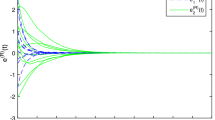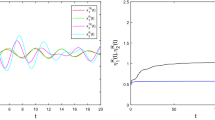Abstract
This paper studies the fixed-time synchronization control of quaternion-valued memristive neural networks (QVMNNs). The QVMNN is the extension of real and complex-valued MNNs, and the activation functions considered in this work are assumed to be discontinuous. Due to the noncommutativity of quaternion multiplication, the QVMNNs model is separated into four real-valued systems by utilizing the differential inclusion theory and decomposition method. Based on the sign function, some discontinuous control schemes are developed. By applying the nonsmooth analysis and inequality techniques, some novel criteria for fixed-time synchronization of QVMNNs are derived. Compared with the previous results, the proposed method based on sign function makes the designed controllers more concise and the established criteria more effective and less conservative. Finally, simulations are proposed to demonstrate the validity and practicability of theoretical results.








Similar content being viewed by others
Data Availability
Data sharing not applicable to this article as no datasets were generated or analyzed during the current study.
References
Chua LO. Memristor-the missing circuit element. IEEE Trans Circuit Theory. 1971;18(5):507–19.
Strukov D, Snider G, Stewart D, Williams RS. The missing memristor found. Nature. 2008;453:80–3.
Miller K, Nalwa KS, Bergerud A, Neihart NM, Chaudhary S. Memristive behavior in thin anodic titania. IEEE Electron Device Lett. 2010;31(7):737–9.
Sun J, Shen Y, Yin Q, Xu C. Compound synchronization of four memristor chaotic oscillator systems and secure communication. Chaos. 2012;23(1):1–10.
Corinto F, Ascoli A, Gilli M. Nonlinear dynamics of memristor oscillators. IEEE Trans Circuits Syst I Reg Papers. 2011;58(6):1323–36.
Pershin YV, Di Ventra M. Experimental demonstration of associative memory with memristive neural networks. Neural Netw. 2010;23(7):881–6.
Cantley KD, Subramaniam A, Stiegler HJ, Chapman RA, Vogel EM. Hebbian learning in spiking neural networks with nanocrystalline silicon TFTs and memristive synapses. IEEE Trans Nanotechnol. 2011;10(5):1066–73.
Wang L, He H, Zeng Z. Global synchronization of fuzzy memristive neural networks with discrete and distributed delays. IEEE Trans Fuzz Syst. 2020;28(9):2022–34.
Chen J, Zeng Z, Jiang P. Global Mittag-Leffler stability and synchronization of memristor-based fractional-order neural networks. Neural Netw. 2014;51:1–8.
Bao H, Cao J. Projective synchronization of fractional order memristor-based neural networks. Neural Netw. 2014;63:1–9.
Wu A, Zeng Z. Lagrange stability of memristive neural networks with discrete and distributed delays. IEEE Trans Neural Netw Learn Syst. 2014;25(4):690–703.
Zhang G, Shen Y. Exponential synchronization of delayed memristor-based chaotic neural networks via periodically intermittent control. Neural Netw. 2014;55:1–10.
Li N, Cao J. Global dissipativity analysis of quaternion-valued memristor-based neural networks with proportional delay. Neurocomputing. 2018;321:103–13.
Simmons GF. Calculus gems: brief lives and memorable mathematics. New York, NY, USA: McGraw-Hill; 1992.
Adler SL. Quaternionic quantum mechanics and quantum fields. New York, NY, USA: Oxford Univ. Press; 1995.
Took CC, Mandic DP. The quaternion LMS algorithm for adaptive filtering of hypercomplex processes. IEEE Trans Signal Process. 2009;57(4):1316–27.
Zou C, Kou K, Wang Y. Quaternion collaborative and sparse representation with application to color face recognition. IEEE Trans Image Process. 2016;25(7):3287–302.
Xia Y, Jahanchahi C, Mandic DP. Quaternion-valued echo state networks. IEEE Trans Neural Netw Learn Syst. 2015;26(4):663–73.
Isokawa T, Kusakabe T, Matsui N, Peper F. Quaternion neural network and its application. In Proc 7th Int Conf KES, Oxford, U.K. 2003;318-324.
Qin S, Feng J, Song J, Wen X, Xu C. A one-layer recurrent neural network for constrained complex-variable convex optimization. IEEE Trans Neural Netw Learn Syst. 2018;29(3):534–44.
Tu Z, Cao J, Alsaedi A, Hayat T. Global dissipativity analysis for delayed quaternion-valued neural networks. Neural Netw. 2017;89:97–104.
Liu Y, Zhang D, Lu J. Global exponential stability for quaternion-valued recurrent neural networks with time-varying delays. Nonlin Dyn. 2017;87(1):553–65.
Song Q, Chen X. Multistability analysis of quaternion-valued neural networks with time delays. IEEE Trans Neural Netw Learn Syst. 2018;29(11).
Chen X, Li Z, Song Q, Hu J, Tan Y. Robust stability analysis of quaternion-valued neural networks with time delays and parameter uncertainties. Neural Netw. 2017;91:55–65.
Liu Y, Zhang D, Lu J, Cao J. Global \(\mu\)-stability criteria for quaternion-valued neural networks with unbounded time-varying delays. Inf Sci. 2016;360:273–88.
Chen X, Song Q. State estimation for quaternion-valued neural networks with multiple time delays. IEEE Trans Syst Man Cybern Syst. 2019;49(11):2278–87.
Liu Y, Zhang D, Lou J, Lu J, Cao J. Stability analysis of quaternion-valued neural networks: decomposition and direct approaches. IEEE Trans Neural Netw Learn Syst. 2018;29(9):4201–11.
Bhat S, Bernstein D. Finite-time stability of continuous autonomous systems. Siam J Control Optim. 2000;38:751–66.
Yang X, Lu J. Finite-time synchronization of coupled networks with Markovian topology and impulsive effects. IEEE Trans Autom Control. 2016;61(8):2256–61.
Polyakov A. Nonlinear feedback design for fixed-time stabilization of linear control systems. IEEE Trans Automat Control. 2012;57(8):2106–10.
Wang L, Zeng Z, Ge M. A disturbance rejection framework for finite-time and fixed-time stabilization of delayed memristive neural networks. IEEE Trans Syst Man Cybern Syst. 2021;51:905–15.
Wei R, Cao J, Alsaedi A. Finite-time and fixed-time synchronization analysis of inertial memristive neural networks with time-varying delays. Cogn Neurodyn. 2018;12(1):121–34.
Hu C, He H, Jiang H. Fixed/preassigned-time synchronization of complex networks via improving fixed-time stability. IEEE Trans Cyber. 2021;51(6):2882–92.
Feng L, Yu J, Hu C, Yang C, Jiang H. Nonseparation method-based finite/fixed-time synchronization of fully complex-valued discontinuous neural networks. IEEE Trans Cybern. 2021;51(6):3212–23.
Ding X, Cao J, Alsaedi A, Hayat T. Robust fixed-time synchronization for uncertain complex-valued neural networks with discontinuous activation functions. Neural Netw. 2017;90:42–55.
Funding
This research was supported by the Natural Science Foundation of Jiangsu Province under Grant No. BK20210635, Key Project of Natural Science Foundation of China (No. 61833005).
Author information
Authors and Affiliations
Corresponding author
Ethics declarations
Ethics Approval
This article does not contain any studies with human participants or animals performed by any of the authors.
Informed Consent
The research is not involved human participants.
Conflict of Interest
The authors declare no competing interests.
Additional information
Publisher’s Note
Springer Nature remains neutral with regard to jurisdictional claims in published maps and institutional affiliations.
Rights and permissions
Springer Nature or its licensor holds exclusive rights to this article under a publishing agreement with the author(s) or other rightsholder(s); author self-archiving of the accepted manuscript version of this article is solely governed by the terms of such publishing agreement and applicable law.
About this article
Cite this article
Wei, R., Cao, J. & Gorbachev, S. Fixed-Time Control for Memristor-Based Quaternion-Valued Neural Networks with Discontinuous Activation Functions. Cogn Comput 15, 50–60 (2023). https://doi.org/10.1007/s12559-022-10057-9
Received:
Accepted:
Published:
Issue Date:
DOI: https://doi.org/10.1007/s12559-022-10057-9




